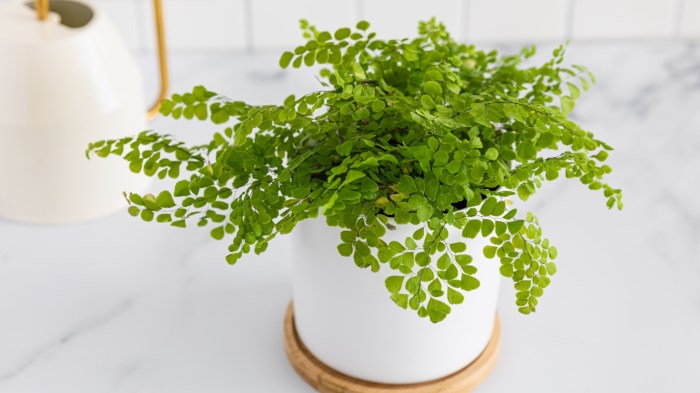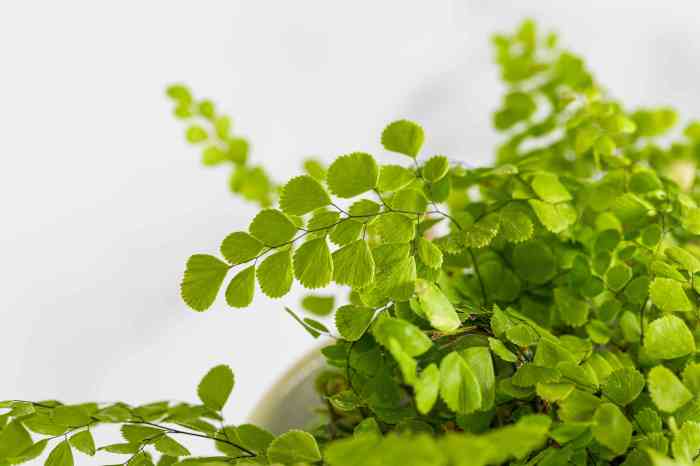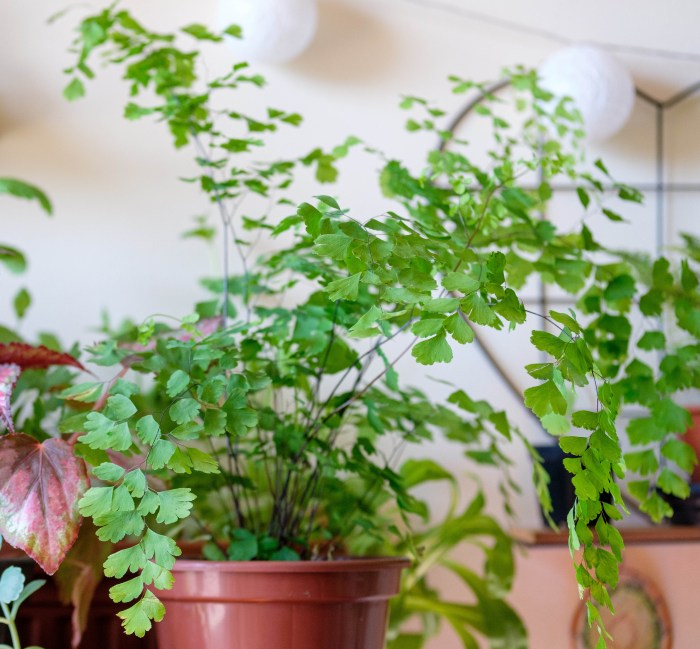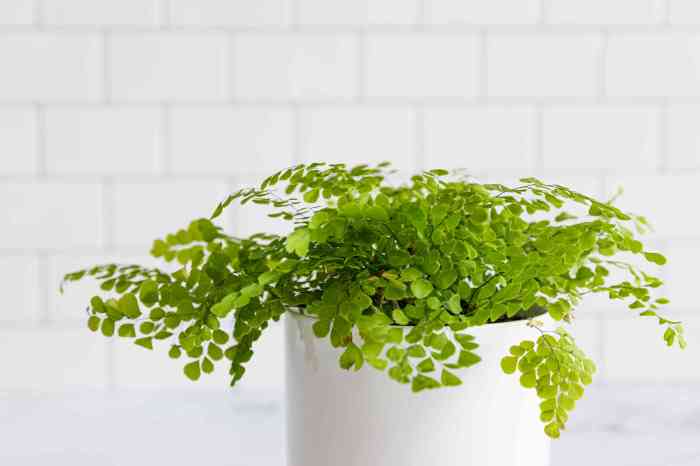Care for maidenhair fern – Discover the enchanting world of maidenhair ferns, where graceful fronds and air-purifying properties intertwine. This comprehensive guide unveils the secrets to cultivating, troubleshooting, and incorporating these delicate plants into your living spaces, creating a haven of beauty and tranquility.
From optimal lighting and humidity levels to effective pest management and design inspiration, this article empowers you to nurture your maidenhair ferns to their fullest potential, transforming them into thriving additions to your home décor.
Cultivation and Care Requirements

Cultivating and caring for maidenhair ferns requires attention to specific environmental factors and cultural practices to ensure their optimal growth and health.
These ferns thrive in well-drained, moist soil, and bright, indirect light. Maintaining consistent humidity levels is crucial, as they are susceptible to desiccation. Fertilizing during the growing season promotes healthy growth, and regular repotting ensures adequate space for root development.
Light Requirements
Maidenhair ferns prefer bright, indirect light. Direct sunlight can scorch their delicate fronds, while low light conditions may hinder their growth.
Temperature Requirements
These ferns prefer warm temperatures ranging from 65 to 75°F (18 to 24°C). Temperatures below 55°F (13°C) can damage their fronds.
Humidity Requirements
Maidenhair ferns require high humidity levels of at least 50%. Regular misting, placement on a pebble tray filled with water, or grouping with other moisture-loving plants can help maintain humidity.
Watering Requirements
Water maidenhair ferns regularly to keep the soil consistently moist but not waterlogged. Allow the top inch of soil to dry out slightly before watering again.
Soil Requirements
These ferns prefer well-drained, organic-rich soil with a pH of 5.5 to 6.5. A mixture of peat moss, perlite, and vermiculite provides a suitable growing medium.
Fertilization Requirements
Fertilize maidenhair ferns during the growing season with a balanced, liquid fertilizer diluted to half strength. Avoid over-fertilizing, as this can damage their roots.
Propagation
Maidenhair ferns can be propagated through division or spores. Division involves separating the fern into smaller clumps, while spore propagation requires collecting and sowing spores from mature fronds.
Maidenhair fern is a delicate fern that requires specific care, such as maintaining high humidity and indirect light. It’s a popular choice for hanging plants indoor due to its graceful fronds that cascade downward. However, proper care is crucial for keeping maidenhair fern healthy and thriving.
Troubleshooting Common Issues
Maidenhair ferns are generally low-maintenance plants, but they can occasionally develop problems. Here are some common issues and how to resolve them:
Yellowing Leaves
Yellowing leaves can be caused by several factors, including:
- Overwatering: Maidenhair ferns prefer moist soil, but overwatering can lead to root rot and yellowing leaves. Allow the top inch of soil to dry out before watering again.
- Underwatering: Too little water can also cause yellowing leaves. Water your fern regularly, especially during the growing season.
- Nutrient deficiency: Yellowing leaves can also be a sign of nutrient deficiency. Fertilize your fern monthly with a balanced fertilizer.
- Sunlight: Maidenhair ferns prefer bright, indirect light. Too much direct sunlight can scorch the leaves and cause them to turn yellow.
Brown Tips
Brown tips on maidenhair fern leaves can be caused by:
- Low humidity: Maidenhair ferns prefer high humidity. If the air is too dry, the tips of the leaves can turn brown and crispy. Use a humidifier or mist your fern regularly to increase the humidity.
- Overfertilization: Too much fertilizer can burn the tips of the leaves. Fertilize your fern monthly with a balanced fertilizer, and do not overfertilize.
- Cold temperatures: Maidenhair ferns are not cold-hardy and can develop brown tips if exposed to cold temperatures. Keep your fern in a warm, draft-free location.
Stunted Growth
Stunted growth in maidenhair ferns can be caused by:
- Lack of light: Maidenhair ferns need bright, indirect light to thrive. If your fern is not getting enough light, it will not grow properly.
- Rootbound: If your fern is rootbound, it will not be able to absorb enough nutrients and water to grow properly. Repot your fern into a larger pot with fresh potting mix.
- Pests: Pests, such as aphids and mealybugs, can damage the leaves and stems of maidenhair ferns, which can lead to stunted growth. Treat your fern with an appropriate insecticide.
Benefits and Uses of Maidenhair Ferns

Maidenhair ferns are renowned not only for their delicate appearance but also for their air-purifying properties and potential health benefits. They are natural air filters, effectively removing toxins and pollutants from the air, making them ideal for indoor environments.
To nurture a flourishing maidenhair fern, ensure it receives ample indirect light, consistent moisture, and well-drained soil. For inspiration on incorporating greenery into your home, explore Discover the Enchanting World of Bunnings Plant Baskets: A Guide to Types Uses and Care . This guide provides insights into selecting and caring for maidenhair ferns in various plant baskets, elevating your indoor space with a touch of nature.
In addition to their air-purifying abilities, maidenhair ferns are believed to promote relaxation and reduce stress levels. Their delicate fronds and soft, feathery texture create a calming and serene atmosphere. Studies have shown that exposure to plants can have a positive impact on mental well-being, reducing anxiety and improving mood.
Incorporating Maidenhair Ferns into Home Decor
Maidenhair ferns are versatile plants that can be incorporated into various home décor styles. Their delicate foliage adds a touch of elegance and greenery to any room. They can be placed on shelves, tables, or windowsills, bringing a sense of tranquility and freshness to the space.
Terrariums and Hanging Baskets
Maidenhair ferns are also excellent choices for terrariums and hanging baskets. Their compact size and ability to thrive in humid environments make them ideal for these enclosed spaces. In terrariums, they create a miniature ecosystem, adding a touch of nature to any room.
In hanging baskets, their cascading fronds create a beautiful and eye-catching display.
Creating a Humid Environment, Care for maidenhair fern
Maidenhair ferns prefer high humidity, making them perfect for creating a humid environment in dry indoor spaces. They can be placed in bathrooms, kitchens, or near humidifiers to increase the moisture levels in the air. This can be beneficial for people with respiratory issues or those who simply want to create a more comfortable and spa-like atmosphere in their homes.
Pest and Disease Management
Maidenhair ferns, while graceful and elegant, are not immune to the occasional pest or disease. Understanding the common issues and implementing preventive measures can ensure the well-being of these delicate plants.
Identifying and addressing infestations or infections promptly is crucial. Common pests that may target maidenhair ferns include aphids, mealybugs, and spider mites. Aphids, tiny green or black insects, feed on the plant’s sap, causing stunted growth and yellowing leaves. Mealybugs, small white insects covered in a waxy substance, can also suck the plant’s sap, leading to wilting and honeydew production.
The maidenhair fern, known for its delicate foliage, thrives in moist, well-draining soil. For optimal growth, consider using Bunnings Outdoor Ceramic Pots, which offer excellent drainage and come in a range of styles to complement your indoor or outdoor décor.
By following the comprehensive guide provided in Bunnings Outdoor Ceramic Pots: A Comprehensive Guide to Styling Planting and Care , you can ensure your maidenhair fern flourishes in its ceramic home.
Spider mites, microscopic pests, spin webs on the undersides of leaves, causing stippling and discoloration.
Natural Pest Control Methods
- Neem Oil:Dilute neem oil with water and spray it on the affected areas. Neem oil has insecticidal properties that can deter pests.
- Insecticidal Soap:Mix insecticidal soap with water and apply it directly to the pests. The soap suffocates the pests and kills them.
- Beneficial Insects:Introduce beneficial insects, such as ladybugs and lacewings, into the environment. These insects prey on pests, providing natural pest control.
In the case of diseases, maidenhair ferns are susceptible to fungal infections such as powdery mildew and botrytis. Powdery mildew manifests as a white powdery substance on the leaves, while botrytis causes gray mold on the leaves and stems. Proper air circulation and avoiding overwatering can help prevent these infections.
When caring for maidenhair ferns, it’s crucial to ensure proper moisture and humidity. Bunnings Orchid Soil: The Ultimate Guide to Nurturing Your Orchids provides valuable insights into creating the ideal growing conditions for orchids, which can also be beneficial for maidenhair ferns.
This comprehensive guide covers soil composition, watering techniques, and humidity maintenance, ensuring that your delicate plants thrive.
Disease Control Methods
- Fungicides:Use organic fungicides, such as copper-based sprays, to treat fungal infections. Follow the manufacturer’s instructions carefully.
- Cultural Practices:Improve air circulation by providing proper spacing between plants. Avoid overwatering and allow the soil to dry out between waterings.
- Quarantine:Isolate infected plants to prevent the spread of disease to healthy plants.
Prevention is key when it comes to pest and disease management for maidenhair ferns. Regular inspection, proper watering and fertilization, and maintaining optimal growing conditions can minimize the risk of infestations or infections. By implementing these measures, you can ensure the health and beauty of your maidenhair ferns for years to come.
Styling and Design Considerations: Care For Maidenhair Fern

Maidenhair ferns, with their delicate foliage and graceful arching fronds, offer a versatile addition to any interior design scheme. Here are some ideas for incorporating these elegant plants into your home:
Incorporating Maidenhair Ferns into Design Styles
Maidenhair ferns can complement a wide range of design styles, from bohemian to modern and traditional. Their airy texture and soft green hues bring a touch of nature and tranquility to any space.
- Bohemian:Pair maidenhair ferns with macrame hangers, woven baskets, and ethnic textiles to create a relaxed and eclectic atmosphere.
- Modern:Combine maidenhair ferns with sleek lines, geometric shapes, and metallic accents for a contemporary and minimalist look.
- Traditional:Use maidenhair ferns to add a touch of elegance to classic interiors, complementing wooden furniture, floral prints, and antique decor.
Creating Lush Fern Walls and Floral Arrangements
Maidenhair ferns can transform a wall into a living artwork. Plant them in a vertical garden or hang them in macrame planters to create a lush and vibrant green tapestry. They also make excellent additions to floral arrangements, adding a delicate and airy touch to bouquets and centerpieces.
Choosing the Right Varieties and Containers
When selecting maidenhair ferns for your design, consider the size and shape of the space. Smaller varieties, such as Adiantum raddianum, are suitable for terrariums or small pots, while larger varieties, like Adiantum capillus-veneris, make a statement in hanging baskets or as floor plants.
Choose containers that complement the fern’s aesthetic, such as ceramic pots for a modern look or terracotta pots for a more traditional feel.
Final Conclusion

Embark on a journey of botanical bliss as you master the art of caring for maidenhair ferns. Whether you seek to purify your air, create a lush fern wall, or simply add a touch of elegance to your surroundings, this guide provides the knowledge and inspiration you need to cultivate these enchanting plants with confidence.
FAQ
How often should I water my maidenhair fern?
Water your maidenhair fern regularly, keeping the soil consistently moist but not soggy. Allow the top inch of soil to dry out slightly between waterings.
Why are the tips of my maidenhair fern turning brown?
Brown tips on maidenhair ferns can be caused by underwatering, low humidity, or exposure to cold drafts. Ensure your fern is receiving adequate moisture, mist it regularly to increase humidity, and protect it from cold temperatures.
How can I propagate my maidenhair fern?
Maidenhair ferns can be propagated through division or spores. Division is the easier method, where you divide the plant into smaller sections and pot them separately. Spore propagation requires more patience and specialized techniques.